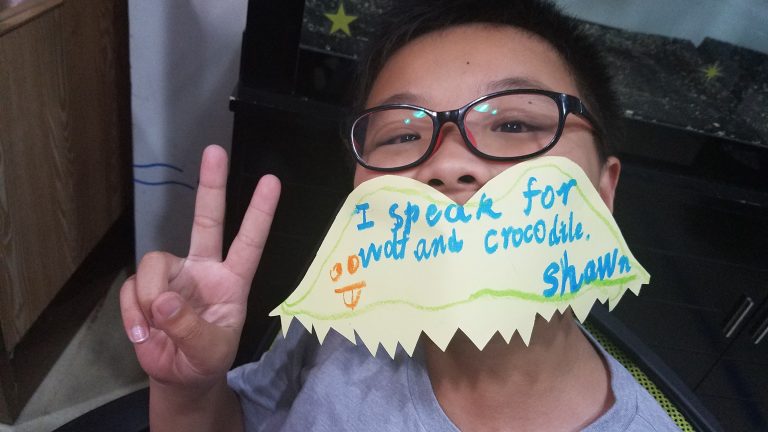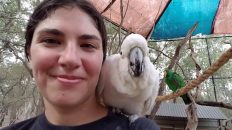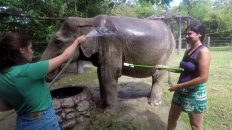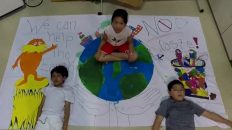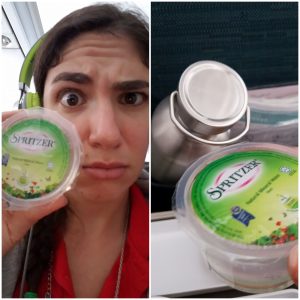 My students and I are waking up to our choices. Every choice we make has a direct impact on the planet, on a tribe, a family, and other individuals.
My students and I are waking up to our choices. Every choice we make has a direct impact on the planet, on a tribe, a family, and other individuals.
We choose to help the planet in any way we can. Do you?
I have discussed the Plastic Waste Issue in China. This year is no different, I have just learned to speak my truth more, and let go of things I cannot control. For example, DT Club, the English program I work for, gives every student a small prize at the end of a school day. You can imagine most of these prizes come in small plastic throw away packaging. Does it bother me? Yeah, sure; but the students learn a lot and are motivated and excited by rewards for learning. I have given suggestions for gifts, and they have given the children reusable utensils and other reusable school items – so I consider this a win.
You can’t say “no thank you” to water, and most of the safe drinking water in China is in a plastic bottle. Our school has a filter, so I fill up my reusable bottle when I am there – but once I am home, the plastic bottle has to come out. It is just how it is here.
Another example – bubble tea is popular with my coworkers; 3 out of 5 days a week someone orders or goes on a bubble tea run. I always say “No thank you” when they offer to get me one. However, if they say “Here, I got you a bubble tea,” I will accept it because I won’t offend someone’s generosity.
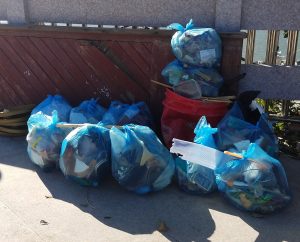 These small choices really do have effects on the planet, and they can turn into something beautiful, when done and said at the right place and time. If you speak your truth and stick to your values, a lot of wonderful things can be achieved.
These small choices really do have effects on the planet, and they can turn into something beautiful, when done and said at the right place and time. If you speak your truth and stick to your values, a lot of wonderful things can be achieved.
Every Friday during summer camp, a group of the older DT Elite students would go on a day trip to a beach, about a 2 hour ride from Wenzhou, where we are located. I went the 3rd week, and knew ahead of time that one of the plans for the day was to go fishing on boats at the beach. I knew that murdering fish was not something I wanted any part of (I can’t stand the smell, and did you know that fish feel all that pain when you hook them with your line?) so I asked our headmaster if I could stay back and pick up trash on the beach. He thought it was a great idea, and we had enough teachers to go on the boats to ensure all the kids were safe.
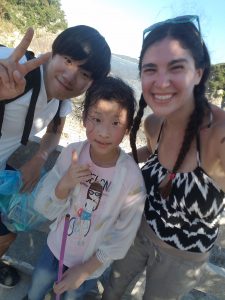 Well, to my excitement, another teacher and one of my students from last year’s Zero Waste class decided to stay and help clean up too! It was a good thing – we had plenty of trash to pick up after typhoon Maria hit the shores the previous week. We picked up so much trash that the three of us could not carry the 15 bags to the proper disposal container, and our other friends – after they finished their fishing trip – came to the rescue! Even on the beach, I decided that I wanted to pick up trash, and another coworker decided to join in. In 15 minutes, we had 3 bags of trash!
Well, to my excitement, another teacher and one of my students from last year’s Zero Waste class decided to stay and help clean up too! It was a good thing – we had plenty of trash to pick up after typhoon Maria hit the shores the previous week. We picked up so much trash that the three of us could not carry the 15 bags to the proper disposal container, and our other friends – after they finished their fishing trip – came to the rescue! Even on the beach, I decided that I wanted to pick up trash, and another coworker decided to join in. In 15 minutes, we had 3 bags of trash!
Yes, when we left there was still trash on the ground. No, I don’t think it was a waste of time. On the contrary, “Unless someone like you cares a whole awful lot, nothing is going to get better, it’s not.” So every little choice we make can and will help the planet, if we decide to.
And that is what the below sets of lessons are about. The unit below is a blueprint for you to use when doing your version of this. Every teacher does it their way, so I am not going to sit here and type word-for-word what I did or said, because you will do it different. You know your students/children the best, so do it your way! As long as you stick to the objective, and use the essential questions to lead your students, you can change the world, one child, one adult, one life lesson at a time.
Lesson: The Detriments of Plastic Waste
Objective: You will learn the negative impacts of oil-based plastic and create a list of alternatives to single use wasteful items in your everyday life.
Vocabulary: Zero Waste, endangered, extinct, fossil fuels, upcycle
Essential question:
- Where does your waste go after you put it in the trash bin?
- How do my everyday actions affect the world?
Materials:
Depending on how you want to do this unit, you will need:
- SMARTboard, or something that plays videos (I used my laptop)
- Also a white board, poster paper, or SMARTboard where you can write on. I am a huge fan of the reusable route, but anchor charts do help in units so kids can refer back to them. I like using the SMARTboard so I can reuse and still refer back to it – but in my school in China, we used the whiteboard.
- Writing journals
- Writing utensils
- Any worksheets – teacher made or ones used from the linked TedEd lessons
- Yellow paper, cut into a Lorax Mustache
- Old tshirts
- Scissors
- Fabric markers (or paint, but markers are less messy and easier for children to manipulate)
- Sewing machine, or hand stitching capabilities (needle and thread)
Procedure:
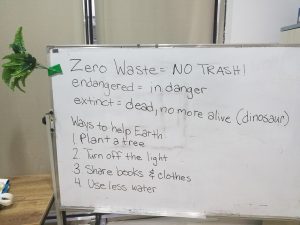 The first week of my Zero Waste class, I had to do some up-front and in-your-face schooling about what happens after you throw something into the trash bin and why we need to be thinking about our environmental impact. There was some realizations of how necessary it was to reduce our individual waste when watching images and videos of birds full of our trash. We made a list of single use items that we throw away, and then thought of some alternatives to them. Some, like plastic bottles and bags were easy to think of alternatives. Others, like straws and sanitary plastic wrap, were more difficult.
The first week of my Zero Waste class, I had to do some up-front and in-your-face schooling about what happens after you throw something into the trash bin and why we need to be thinking about our environmental impact. There was some realizations of how necessary it was to reduce our individual waste when watching images and videos of birds full of our trash. We made a list of single use items that we throw away, and then thought of some alternatives to them. Some, like plastic bottles and bags were easy to think of alternatives. Others, like straws and sanitary plastic wrap, were more difficult.
We talked and thought about our favorite animals, and why they were important. After I told them that giraffes and elephants were endangered, one girl said “What? I thought there were a lot of them where they lived.” And the sad truth is – most people don’t know that there are so many animals, plant, and marine life that we are hunting and harming to extinction. In my classroom in Newark, we had the time to go through this visual of extinct animals, and talked about how most animals go extinct because humans overhunt them or tear their homes apart/take them for human use.
Education is so important.
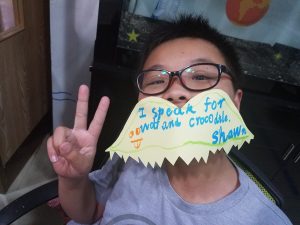 The next week, we got into studying how recycling facilities run, how plastic is made, what fossil fuels are, and why they are detrimental to the environment. We also discussed the importance and possibilities of using renewable energies to help diminish our environmental impact. Most students did not realize how much of our stuff is made from oil and gas, nor the affects drilling for oil has on the environment. I used videos and lesson materials from TedEd to get a lot of the resource inspiration for my lessons.
The next week, we got into studying how recycling facilities run, how plastic is made, what fossil fuels are, and why they are detrimental to the environment. We also discussed the importance and possibilities of using renewable energies to help diminish our environmental impact. Most students did not realize how much of our stuff is made from oil and gas, nor the affects drilling for oil has on the environment. I used videos and lesson materials from TedEd to get a lot of the resource inspiration for my lessons.
What we did after the academic, was something fun – we learned to upcycle! Upcycling is when you make something into something else. It can also be ‘reusing’ but you’re using something again in a different way. I showed them the video I created a year and a half ago with my NJRDS students and their inclusion friends upcycling tshirts into reusable bags. We then did it ourselves, and made them into bags. The sleeves of the tshirts I then sewed to make a holder for reusable utensils – which included their gifts from the program, and utensils I bought from Ikea.
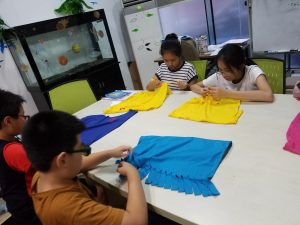
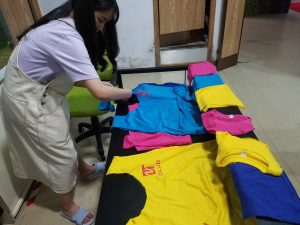
To make a (No-sew) Tshirt bag:
- Get reusable tshirt/s
- Cut the sleeves off (try to cut on the outside of the seam) to make the handles.
- Get a circular object (I used a plate) and with fabric marker, draw a semicircle around the neck/head area of the tshirt. This should make a dip in the tshirt.
- You have created the top of your reusable bag!
- Go to the bottom of the tshirt, and make 3-5 inch (depends on how frilly you want your bag at the bottom – if you want ‘no frills, turn the tshirt inside out before tying your knots) slits on either side of the tshirt – right my the seams.
- Move 1-1.5 inches, and then make a similar slit. Continue to do so until the entire bottom is cut and covered.
- Make an ‘x’ knot using one rectangular slit material from the front and back of the tshirt.
- Repeat on same slit (do the knot twice)
- Continue this until all slits are knotted and your bottom is fabulous.
- Add any drawings you want to!
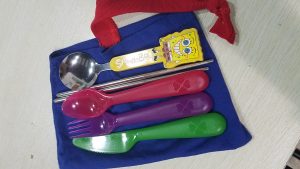 To make a reusable utensil bag:
To make a reusable utensil bag:
- Take the collar of your tshirt and cut off any extra tshirt material around it.
- Cut the collar in half on both sides (making two pieces).
- Sew the cut up part of the tshirt sleeve in a straight stitch.
- Take one piece of the collar, and place it in the middle of the top of the sleeve (the part that is not sewn on the bottom – the open part of the bag). Connect it by sewing a square around the collar piece and the sleeve.
- Make a knot at the end of the collar piece, or sew a bead onto it.
- Voila! You can put your utensils into the bag and use/reuse it!
- You can do it with both sleeves and make two!
I stressed to them that the whole point is to use these items on a regular basis; to bring them everywhere so you can always be prepared to reduce your waste. I showed them my Zero Waste kit, and we went on continuing to empower each other to make good choices. Anytime I had a bubble tea gift, I can promise you they called me out on it!
Stay tuned, because the two weeks after were made around a big Earth project and pledge!


